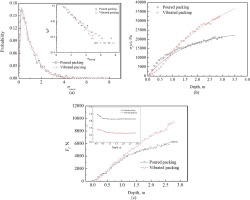当前位置:
X-MOL 学术
›
Powder Technol.
›
论文详情
Our official English website, www.x-mol.net, welcomes your
feedback! (Note: you will need to create a separate account there.)
DEM simulation on the vibrated packing densification of mono-sized equilateral cylindrical particles
Powder Technology ( IF 4.5 ) Pub Date : 2018-02-01 , DOI: 10.1016/j.powtec.2017.10.050 Quan Qian , Lin Wang , Xizhong An , Yongli Wu , Ju Wang , Haiyang Zhao , Xiaohong Yang
Powder Technology ( IF 4.5 ) Pub Date : 2018-02-01 , DOI: 10.1016/j.powtec.2017.10.050 Quan Qian , Lin Wang , Xizhong An , Yongli Wu , Ju Wang , Haiyang Zhao , Xiaohong Yang

|
Abstract The packing densification of mono-sized equilateral cylindrical particles under mechanical vibration is numerically reproduced using discrete element method (DEM). The influences of vibration frequency, amplitude and container size on the macro property (e.g. packing density) of each packing are studied. Meanwhile, various micro-properties including coordination number (CN), radial distribution function (RDF), local structures, contact types, particle position/orientation distributions, forces/stresses of the vibrated dense packing are characterized and compared with those of the loose initial poured packing. The results show that properly controlling vibration conditions can realize the transition of equilateral cylindrical particles from random loose packing (RLP) to random close packing (RCP). The maximum packing density without wall effects can reach about 0.7166, which agrees with experimental and numerical results in literature. Micro property analyses demonstrate that the average CN increases slightly after vibration. The RDF curves indicate three obvious peaks for both poured and vibrated packings. The distributions of intersection angles imply that the perpendicular arrangements of the cylindrical particles are common in both packing structures. From RLP to RCP, the probability of side-edge, bottom-edge and edge-edge contacts between two particles decreases, while that of side-side, side-bottom and bottom-bottom contacts increases. Both particle position and orientation distributions illustrate that the structure in the center of the vibrated packing is disordered. The distribution of strong forces follows the exponential law, while that of weak forces follows the power law. The static vertical stresses in both packings can be predicted by Janssen model. After vibration, a much denser and more stable structure with a larger saturation stress is obtained due to the reducing inter-particle friction effects.
中文翻译:

等边圆柱颗粒振动堆积致密化的DEM模拟
摘要 使用离散元法(DEM)数值再现了机械振动下单尺寸等边圆柱颗粒的堆积致密化。研究了振动频率、振幅和容器尺寸对每种填料宏观性能(如填料密度)的影响。同时,表征了振动致密堆积的配位数(CN)、径向分布函数(RDF)、局部结构、接触类型、粒子位置/取向分布、力/应力等各种微观性质,并与松散初始倒包装。结果表明,适当控制振动条件可以实现等边圆柱颗粒从随机松散堆积(RLP)到随机密堆积(RCP)的转变。没有壁面效应的最大堆积密度可以达到约 0.7166,这与文献中的实验和数值结果一致。微观特性分析表明,振动后平均 CN 略有增加。RDF 曲线显示了浇注和振动填料的三个明显峰。交叉角的分布意味着圆柱形颗粒的垂直排列在两种填料结构中是常见的。从 RLP 到 RCP,两个粒子之间的侧边、底边和边边接触的概率降低,而侧边、侧底和底底接触的概率增加。颗粒位置和取向分布都表明振动填料中心的结构是无序的。强力的分布遵循指数规律,而弱力则遵循幂律。Janssen 模型可以预测两种填料中的静态垂直应力。振动后,由于减少了颗粒间摩擦效应,获得了具有更大饱和应力的更致密和更稳定的结构。
更新日期:2018-02-01
中文翻译:

等边圆柱颗粒振动堆积致密化的DEM模拟
摘要 使用离散元法(DEM)数值再现了机械振动下单尺寸等边圆柱颗粒的堆积致密化。研究了振动频率、振幅和容器尺寸对每种填料宏观性能(如填料密度)的影响。同时,表征了振动致密堆积的配位数(CN)、径向分布函数(RDF)、局部结构、接触类型、粒子位置/取向分布、力/应力等各种微观性质,并与松散初始倒包装。结果表明,适当控制振动条件可以实现等边圆柱颗粒从随机松散堆积(RLP)到随机密堆积(RCP)的转变。没有壁面效应的最大堆积密度可以达到约 0.7166,这与文献中的实验和数值结果一致。微观特性分析表明,振动后平均 CN 略有增加。RDF 曲线显示了浇注和振动填料的三个明显峰。交叉角的分布意味着圆柱形颗粒的垂直排列在两种填料结构中是常见的。从 RLP 到 RCP,两个粒子之间的侧边、底边和边边接触的概率降低,而侧边、侧底和底底接触的概率增加。颗粒位置和取向分布都表明振动填料中心的结构是无序的。强力的分布遵循指数规律,而弱力则遵循幂律。Janssen 模型可以预测两种填料中的静态垂直应力。振动后,由于减少了颗粒间摩擦效应,获得了具有更大饱和应力的更致密和更稳定的结构。











































 京公网安备 11010802027423号
京公网安备 11010802027423号